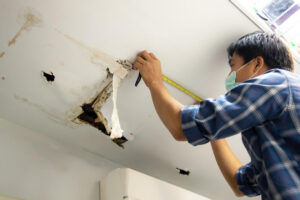Cracks and stains on the ceiling can detract from the overall look of a room. Water leaks, roof truss uplift, or age often cause them. For more information visit Perth Insulation.
More serious issues like a sagging ceiling can require major repairs that may need new beams. Any signs of damage should be fixed immediately as they could lead to structural problems and microbial growth.

When cracks show up in the ceiling, homeowners are often anxious about what they mean. Even hairline fissures can fuel worries that heavy chunks of plaster will soon fall on your head, but in reality, cracks in the ceiling are more common than people think and rarely a sign of major problems.
Drywall cracks usually happen because of movement in the structure behind them, such as floor joists sagging in a second story or a shift in ground moisture that causes a new house to settle and settle again. They can also be caused by leakage from the ceiling, such as from a dripping shower or bath, or by water seepage through joints in the attic and down the drywall.
Leaking ceilings can cause various problems, including discolored cracks that look like spider webs (because they branch out in the same pattern as the web). These kinds of cracks are most commonly caused by water damage and are usually easy to repair, although it is important to find the source of the leak.
A narrow bead of a compressible white caulk kept to the crack only and not troweled into the rest of the ceiling surface will sometimes seal it. However, if the crack is very wide or runs from the wall through the ceiling, it may be a sign of structural damage, and you should have it checked out by a professional.
When repairing a cracked ceiling, it is crucial to use a product that matches the texture of the rest of the ceiling. Otherwise, the cracks will be more visible. There are some commercial products available in sprays and semi-liquids that can be sprayed on or applied with a sponge.
When working on a ceiling, you should wear protective eyewear and a dust mask. It’s also a good idea to have a sturdy ladder available for working overhead and to ensure the ceiling is well-supported before adding anything heavy, such as furniture or a hanging fixture.
Nothing makes a home look worse than water stains on the ceiling. These discolored scars are caused by leaks, usually from the roof (but sometimes from heating appliances or plumbing). If the water stain is still visible after you’ve stopped the leak and given it time to dry out completely, you can cover it with ceiling paint that contains a stain block or stain sealant. Otherwise, it’s necessary to remove the stained drywall and replace it.
Before you do anything to the stains, take a ladder up and touch them. If they’re dry, there may not be a leak, but it’s always a good idea to check the area to see if it could turn into mold or rot. If the stain is wet, however, you need to call a professional to locate and repair the source of the leak as soon as possible.
Water stains are the result of condensation rather than a leak. This is more common in homes with poor insulation or attic ventilation, and various things, including humidity and dust, can cause it. If you suspect this is the cause of your ceiling water stains, try using a bleach solution to kill the surface mold causing them and then wipe away the affected areas with clean water.
Water stains on the ceiling can be distinguished by shape and color. Typically, they’re much darker than different stains and may even have an edge that appears wet. They also tend to be more amorphous than other stains, which can help you determine whether or not they’re from water.
If you can determine that the water stains on your ceiling are actually from condensation, then you’ll want to address the cause and improve the ventilation in your home as soon as possible. It’s important to remember that covering up a water stain on the ceiling won’t solve the problem; the stains will reappear quickly as the cause isn’t addressed.
Mold in a ceiling usually indicates a serious problem that requires professional remediation. Depending on the type of mold, it can be toxic and cause structural damage to the home. Mold spores can also be circulated throughout the house by fans and, if inhaled, may trigger respiratory problems in sensitive people. A professional must inspect and determine the source of the mold before attempting to clean it.
Often, mold appears as dark stains on the ceiling and may be visible from the room below. Various factors, including water intrusion or a lack of ventilation, can cause mold stains on the ceiling. Regardless of the cause, it is critical to address the underlying issue and repair any leaks before removing the mold from the ceiling.
The first step in removing mold from a ceiling is to kill the mold spores with a bleach solution. Before you begin cleaning, it is important to take the proper precautions and wear a face mask, gloves, and protective eyewear. Open some windows and turn on a fan in the room that you are working in. This will help improve the ventilation while scrubbing and prevent the spread of mold spores from the ceiling to other areas in the home.
A mixture of one part dishwashing liquid, one part chlorine bleach, and four parts water is a suitable cleaning solution. Mix the solution in a spray bottle and apply it to the affected area on the ceiling. Be sure to use a sturdy ladder and test the solution on a small area before applying it to the entire surface. Allow the solution to sit for a few minutes, and then scrub the area with an abrasive sponge or scrub brush. Repeat as needed to eliminate the mold stains.
If a moldy ceiling is not repaired promptly, it can grow through the new paint and cause even more damage to the home. If the mold is not a toxic type, painting over it may not be harmful, but this option does not address the underlying moisture problem and will likely result in more frequent recurrences of the issue.
When a ceiling begins to sag, it can be a serious problem that affects the integrity of your home. It’s not just a cosmetic issue; it can also allow water and pests to enter your living space and may pose a safety hazard for children or elderly family members. For these reasons, it’s important to get a sagging ceiling repaired as soon as you notice it.
There are some causes of sagging in the ceiling, including water damage and poor construction. If the original builder cut corners or screwed the drywall to the lath with a hammer and nails, this can cause sagging over time. Similarly, homes built with drywall that is too light will struggle to support the weight of a ceiling.
Water damage is the most common culprit of sagging ceilings. Undetected leaks from upstairs bathrooms can cause water to accumulate inside the ceiling, weakening the plaster or drywall and causing it to hang over time. If the water isn’t stopped, it can eventually lead to rot and collapse of the entire ceiling.
Paint peeling is another common cause of sagging in the ceiling. Regularly peeling paint isn’t just an aesthetic issue, but it can also indicate that the wood that supports the ceiling has become rotten or weakened from moisture.
A bad patch job can also cause a ceiling to sag. If a section of the ceiling has been patched up with new drywall, this can pull the rest of the plaster away from the ceiling joists and cause them to warp. It’s always best to call in a professional for a ceiling repair when there are any issues with the structure of your home.
Other problems that can cause sagging in the ceiling include termites and white ants, which are known to destroy load-bearing timber structures, causing them to sag or even collapse. If you suspect that your home is at risk of these problems, then it’s essential to have a building inspector check it out as soon as possible. By doing this, you can ensure that your home is safe and secure for your family.
